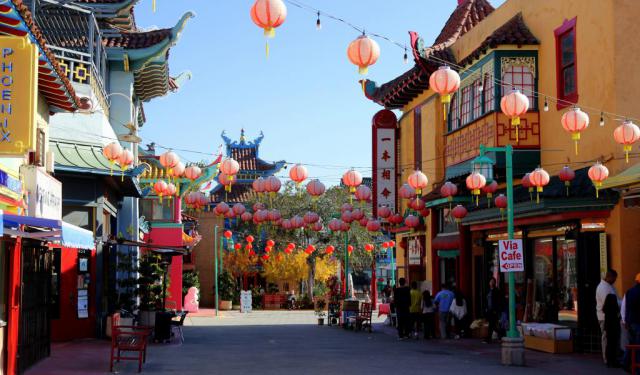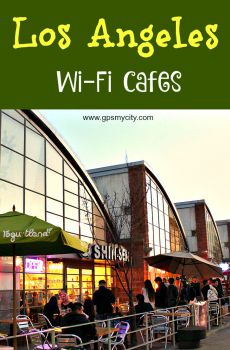La Brea Tar Pits, Los Angeles
La Brea Tar Pits is one of the world’s most famous fossil localities. It is a series of asphalt deposits that have trapped various types of animals, plants, mammals, birds, insects and even dinosaurs, since the Ice Age in North America. There can be seen 40000 years old fossils of mastodons, saber-tooth cats, giant ground sloths, individual plant cells, coyotes, horses and birds.
The La Brea Tar Pits and Hancock Park are situated within what was once the Mexican land grant of Rancho La Brea, now part of urban Los Angeles in the Miracle Mile district, adjacent to the Los Angeles County Museum of Art and the Craft and Folk Art Museum.
Tar pits are composed of heavy oil fractions called asphaltum, which seeped from the earth as oil. In Hancock Park, crude oil seeps up along the 6th Street Fault from the Salt Lake Oil Field, which underlies much of the Fairfax District north of the park. The oil reaches the surface and forms pools at several locations in the park, becoming asphalt as the lighter fractions of the petroleum biodegrade or evaporate.
This seepage has been happening for tens of thousands of years. From time to time, the asphalt would form a deposit thick enough to trap animals, and the surface would be covered with layers of water, dust, or leaves. Animals would wander in, become trapped, and eventually die. Predators would enter to eat the trapped animals and also become stuck.
The tar pits visible today are actually from human excavation. The lake pit was originally an asphalt mine. The other pits visible today were produced between 1913 and 1915, when over 100 pits were excavated in search of large mammal bones. Various combinations of asphaltum and water have since filled in these holes. Normally, the asphalt appears in vents, hardening as it oozes out, to form stubby mounds. These can be seen in several areas of the park.
As the bones of dead animals sink into the asphalt, it soaks into them, turning them a dark-brown or black color. Lighter fractions of petroleum evaporate from the asphalt, leaving a more solid substance, which encases the bones. Apart from the dramatic fossils of large mammals, the asphalt also preserves microfossils: wood and plant remnants, rodent bones, insects, mollusks, dust, seeds, leaves, and even pollen grains. Examples of some of these are on display in the museum.
Radiometric dating of preserved wood and bones has given an age of 38,000 years for the oldest known material from the La Brea seeps. The pits still ensnare organisms today, so most of the pits are fenced to protect humans and animals.
The La Brea Tar Pits and Hancock Park are situated within what was once the Mexican land grant of Rancho La Brea, now part of urban Los Angeles in the Miracle Mile district, adjacent to the Los Angeles County Museum of Art and the Craft and Folk Art Museum.
Tar pits are composed of heavy oil fractions called asphaltum, which seeped from the earth as oil. In Hancock Park, crude oil seeps up along the 6th Street Fault from the Salt Lake Oil Field, which underlies much of the Fairfax District north of the park. The oil reaches the surface and forms pools at several locations in the park, becoming asphalt as the lighter fractions of the petroleum biodegrade or evaporate.
This seepage has been happening for tens of thousands of years. From time to time, the asphalt would form a deposit thick enough to trap animals, and the surface would be covered with layers of water, dust, or leaves. Animals would wander in, become trapped, and eventually die. Predators would enter to eat the trapped animals and also become stuck.
The tar pits visible today are actually from human excavation. The lake pit was originally an asphalt mine. The other pits visible today were produced between 1913 and 1915, when over 100 pits were excavated in search of large mammal bones. Various combinations of asphaltum and water have since filled in these holes. Normally, the asphalt appears in vents, hardening as it oozes out, to form stubby mounds. These can be seen in several areas of the park.
As the bones of dead animals sink into the asphalt, it soaks into them, turning them a dark-brown or black color. Lighter fractions of petroleum evaporate from the asphalt, leaving a more solid substance, which encases the bones. Apart from the dramatic fossils of large mammals, the asphalt also preserves microfossils: wood and plant remnants, rodent bones, insects, mollusks, dust, seeds, leaves, and even pollen grains. Examples of some of these are on display in the museum.
Radiometric dating of preserved wood and bones has given an age of 38,000 years for the oldest known material from the La Brea seeps. The pits still ensnare organisms today, so most of the pits are fenced to protect humans and animals.
Want to visit this sight? Check out these Self-Guided Walking Tours in Los Angeles. Alternatively, you can download the mobile app "GPSmyCity: Walks in 1K+ Cities" from Apple App Store or Google Play Store. The app turns your mobile device to a personal tour guide and it works offline, so no data plan is needed when traveling abroad.
La Brea Tar Pits on Map
Sight Name: La Brea Tar Pits
Sight Location: Los Angeles, USA (See walking tours in Los Angeles)
Sight Type: Attraction/Landmark
Sight Location: Los Angeles, USA (See walking tours in Los Angeles)
Sight Type: Attraction/Landmark
Walking Tours in Los Angeles, California
Create Your Own Walk in Los Angeles
Creating your own self-guided walk in Los Angeles is easy and fun. Choose the city attractions that you want to see and a walk route map will be created just for you. You can even set your hotel as the start point of the walk.
Chinatown Walking Tour
Unlike other cities where Chinese immigrant neighborhoods were formed organically, the Los Angeles Chinatown is the only planned Chinatown in the US. A blend of Chinese and American architecture, it was developed in downtown LA, as a tourist attraction, in the 1930s.
Designed by Hollywood artists as a "Chinese" movie prop to create an exotic atmosphere, LA's Chinatown gives out... view more
Tour Duration: 1 Hour(s)
Travel Distance: 1.7 Km or 1.1 Miles
Designed by Hollywood artists as a "Chinese" movie prop to create an exotic atmosphere, LA's Chinatown gives out... view more
Tour Duration: 1 Hour(s)
Travel Distance: 1.7 Km or 1.1 Miles
Beverly Hills Walking Tour
Undeniably one of the most famous places in the world, Beverly Hills is widely known as the most fashionable destination in Los Angeles county to shop and have fun at. Originally a Mexican ranch where lima beans were once grown, this place has long been a home to many Hollywood stars and other celebrities, luxurious hotels, and high-end boutiques.
Beverly Hills started to gain prominence in the... view more
Tour Duration: 2 Hour(s)
Travel Distance: 2.7 Km or 1.7 Miles
Beverly Hills started to gain prominence in the... view more
Tour Duration: 2 Hour(s)
Travel Distance: 2.7 Km or 1.7 Miles
Movie Studios Tour
The film studios of Los Angeles, collectively known as the “dream factory”, are indeed factories. Here, countless iconic films and television shows have been produced over the years, creating stars and attracting great movie-makers from around the globe. Let's take a brief look at some of these vital hubs in the entertainment industry.
Raleigh Studios is one of the oldest continuously... view more
Tour Duration: 2 Hour(s)
Travel Distance: 3.9 Km or 2.4 Miles
Raleigh Studios is one of the oldest continuously... view more
Tour Duration: 2 Hour(s)
Travel Distance: 3.9 Km or 2.4 Miles
El Pueblo and Little Tokyo Walk
El Pueblo and Little Tokyo are two culturally rich and historically significant neighborhoods in Los Angeles.
The former is the oldest district in the city. Also known as the birthplace of Los Angeles, El Pueblo is centered around the Los Angeles Plaza. Throughout most of the 19th century, it was the city's administrative and commercial center: first under the Spanish (from 1781 to 1821),... view more
Tour Duration: 2 Hour(s)
Travel Distance: 2.2 Km or 1.4 Miles
The former is the oldest district in the city. Also known as the birthplace of Los Angeles, El Pueblo is centered around the Los Angeles Plaza. Throughout most of the 19th century, it was the city's administrative and commercial center: first under the Spanish (from 1781 to 1821),... view more
Tour Duration: 2 Hour(s)
Travel Distance: 2.2 Km or 1.4 Miles
Downtown Architecture Walking Tour
For different people, Los Angeles means different things. One such is undoubtedly architecture. Being one of the centers of the Art Deco movement, LA features a great number of amazing historic houses and buildings attributed to this and other, older and more modern styles.
One prominent landmark is the Cathedral of Our Lady of the Angels, a contemporary construction masterpiece with its... view more
Tour Duration: 2 Hour(s)
Travel Distance: 2.6 Km or 1.6 Miles
One prominent landmark is the Cathedral of Our Lady of the Angels, a contemporary construction masterpiece with its... view more
Tour Duration: 2 Hour(s)
Travel Distance: 2.6 Km or 1.6 Miles
Los Angeles Downtown Walking Tour
The history of Los Angeles – "a bright and guilty place," as Orson Welles described it – began on September 4, 1781, when a group of 44 Spanish settlers established a hamlet on the territory of present-day Downtown LA which they called “The Town of Our Lady the Queen of the Angels” (El Pueblo de Nuestra Señora la Reina de los Ángeles).
The land became part of Mexico in 1821,... view more
Tour Duration: 2 Hour(s)
Travel Distance: 3.5 Km or 2.2 Miles
The land became part of Mexico in 1821,... view more
Tour Duration: 2 Hour(s)
Travel Distance: 3.5 Km or 2.2 Miles
Useful Travel Guides for Planning Your Trip
11 Charming Cafes with Fast and Free Wifi in Los Angeles
Need to find free wireless connection AND a great cup of coffee? These charming cafes, hot-spots and writers’ hang-outs are scattered across LA but catalogued by neighborhood. These indie cafes cater to screenwriters, students and tourists who want to set up camp with their laptops for a few hours...
9 Amazing Food to Try in Los Angeles (LA)
I love food. You love food too. And because we’re foodies, we want every meal to be as good as if it were our last. So for those few times us foodies sit at a table and unexpectedly strike gold, we must remember, honor and share that memorable meal. Here is a list of affordable LA area culinary...
Los Angeles: 15 Souvenir Shopping Tips and Ideas for Travelers
With some many celebrities per square mile, living or just visiting, practically any stone in LA could pass for a souvenir that one time or another was touched, held or walked upon by some of the movie or rock stars, or was filmed in one of the many movies shot in the City of Angels for almost a...











.jpg)
